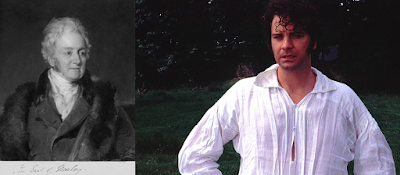Take a trip to Calke Abbey in the company of Joana Starnes, Jane Austen and some illustrious residents!
---oOo---
Amid the rolling countryside of South Derbyshire, there is a great house, Calke Abbey, home of the Harpurs for over 360 years. The family fortunes were founded in the middle of the 16th century by Richard Harpur, a successful lawyer who rose to be one of the judges of the Court of the Common Pleas at Westminster and the Chief Justice of the County Palatinate of Lancaster. To the considerable estate built during the course of his career, he added through an auspicious marriage that established the Harpurs as one of the most notable landowners in the area.
 His descendants did not fail to make him proud and the family fortunes grew and grew. By the 18th century, in the words of the historian William Wooley, the Harpurs were ‘reckoned the best landed Family of any Commoners in this or any of the neighbouring Countys’.
His descendants did not fail to make him proud and the family fortunes grew and grew. By the 18th century, in the words of the historian William Wooley, the Harpurs were ‘reckoned the best landed Family of any Commoners in this or any of the neighbouring Countys’.
Enter Sir Henry Harpur-Crewe, the 7th baronet, who inherited the estate at only 25 years of age, and thus became one of the richest and most eligible landowners in Derbyshire, with an income of £10000 a year. (‘Ten thousand a year, my dear, and very likely more!’)
His portrait catches the visitors’ eye as soon as they walk into the saloon. On a background of sun-tinted clouds and imposing columns stands the future baronet alongside his mother. He was only three when the portrait was painted so, as was the custom of the time, he was immortalised wearing long cream skirts adorned with a wide sash. The attire, along with the very delicate features and the angelic smile, could easily lead the unsuspecting to think it was the portrait of a very beautiful little girl.
 His features retained their delicate beauty as he grew older and a 1784 pastel shows him as a good-looking albeit rather solemn young man.
His features retained their delicate beauty as he grew older and a 1784 pastel shows him as a good-looking albeit rather solemn young man.
And solemn he was indeed. His French tutor remarked during his Grand Tour that while he had an unusual amount of knowledge for a young Englishman of his age, he also had an equally unusual taste for solitude. To his relations’ dismay, this did not change when he came into his inheritance, but it was not long until they had a great deal more to worry about. Sir Henry Harpur fell in love with a young lady well beneath his station – a lady’s maid no less, with whom he lived in a small house in Calke Park before committing the ultimate impropriety and marrying her. There is great gentleness and outstanding beauty in Lady Harpur’s likeness (Miss Nanette Hawkins as was), so the romantic might choose to believe that she was as sweet and kind as the portrait shows her and that, regardless of what society thought, she was a blessing for the very sensitive and unsociable young man. For the world at large the union was a mésalliance, but Sir Henry cared little for their disapproval and spent his life in isolation at Calke with his pheasants, his wife and their eight surviving children.
He was not the first nor the last to cross class boundaries. Some chose to cross even wider gulfs, as was the case with Sir Harry Fetherstonhaugh of Uppark who married his dairymaid in 1825, when he was over seventy and she barely twenty. Compared to the strong reaction such unequal marriages must have elicited in fashionable circles, a gentleman of ten thousand a year marrying a lady’s companion, a gentlewoman fallen on hard times, would have caused far less noticeable ripples.
This is the premise I have chosen for my latest Pride & Prejudice variation, ‘Miss Darcy’s Companion’.
The gentlewoman fallen on hard times is of course Miss Elizabeth Bennet who, after her father’s passing, felt compelled to make her own way into the world. Thus she gets to see Mr Darcy’s Pemberley persona first, his best side, rather than the one he would present to strangers at a country town assembly. As for Mr Darcy, he gets to appreciate Miss Bennet’s sterling qualities and her bewitching self without the millstone of her loud-mouthed and mortifying relations. But what of the burden of expectations placed on him, what of the duty to his lineage and estate? Would Mr Darcy cross boundaries to follow his heart, despite all the obstacles of which he is well aware?
* * * *
“So what now?”
“What are you asking?” Darcy parried the question with another, although he knew precisely what Fitzwilliam’s meaning was, just as well as his cousin knew that he was stalling. But he was indulged nevertheless and the other elaborated:
“Will you marry her?”
Darcy sighed.
“I have not had a chance to put two thoughts together. This is all… very sudden. And there is much to consider, Georgiana’s prospects high up on that list. How would it look on her coming out if her former companion had become her sister? Several years ago Sir Henry Harpur of Calke married his mother’s lady’s maid, and still no one receives them. Harpur could not care less, but then he had always been somewhat of a recluse and kept his distance from society, fashionable or otherwise. I do not have that luxury. Still, having said that, there is a world of difference between a lady’s maid and a lady’s companion.”
The sigh was echoed from the other side of the large desk.
“Not to some. And, needless to say, my relations would be of no assistance. Pater would be as mad as snakes and my brother’s sweet wife would be spitting feathers,” Fitzwilliam chortled ruefully.
“As would Lady Catherine, but that is no surprise. Even your mother, for all her understanding kindness, would say that I could have chosen a vast deal better.”
“And so you could. There is no doubting that.”
(Miss Darcy’s Companion ~ Chapter 11)
* * * *
If this premise intrigues you, dear readers, please leave a comment for a chance to win a Kindle copy of ‘Miss Darcy’s Companion’, available internationally, and thanks for stopping by to meet Sir Henry.
Many thanks, Catherine, it was so kind of you to welcome me here today to talk about the people who, to some extent, have inspired my fiction. I say to some extent because unlike Sir Henry Harpur-Crewe, Mr Darcy would never be an eccentric recluse, nor would he set up house with a mistress, somewhere on the estate. But it is reassuring to know or at least imagine that there was a real-life Georgian gentleman of ten thousand a year who followed his heart and married someone who made him happy.
(History of Calke Abbey and the Harpurs – from the National Trust guidebook, 1989, pp.34-39)
About the author:
Joana Starnes lives in the South of England with her family. She has published six Austen-related novels:
- From This Day Forward ~ The Darcys of Pemberley ~ A Pride & Prejudice sequel
- The Subsequent Proposal ~ A Tale of Pride, Prejudice and Persuasion
- The Second Chance ~ A Pride & Prejudice – Sense & Sensibility Variation
- The Falmouth Connection ~ A Pride & Prejudice Variation set in Poldark territory
- The Unthinkable Triangle ~ A Pride & Prejudice Variation, where loyalty comes at loggerheads with love
- Miss Darcy’s Companion ~ A Pride & Prejudice Variation
They are available on all Amazon sites.
You can connect with Joana Starnes on
Written content of this post copyright © Joana Starnes, 2016.













